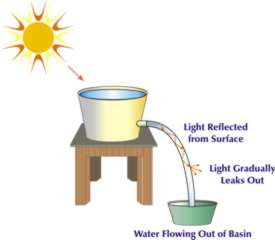
HISTORY
The Nineteenth Century
In 1870, John Tyndall, using a jet of water that flowed from one container to another and a beam of light, demonstrated that light used internal reflection to follow a specific path. As water poured out through the spout of the first container, Tyndall directed a beam of sunlight at the path of the water. The light, as seen by the audience, followed a zigzag path inside the curved path of the water. This simple experiment, illustrated in Figure 1, marked the first research into the guided transmission of light.

The Twentieth Century
Fiber optic technology experienced a phenomenal rate of progress in the second half of the twentieth century. Early success came during the 1950’s with the development of the fiberscope. This image-transmitting device, which used the first practical all-glass fiber, was concurrently devised by Brian O’Brien at the American Optical Company and Narinder Kapany (who first coined the term “fiber optics” in 1956) and colleagues at the Imperial College of Science and Technology in London. Early all-glass fibers experienced excessive optical loss, the loss of the light signal as it traveled the fiber, limiting transmission distances.
Applications in the World
The U.S. military moved quickly to use fiber optics for improved communications and tactical systems. In the early 1970’s, the U.S. Navy installed a fiber optic telephone link aboard the U.S.S. Little Rock. The Air Force followed suit by developing its Airborne Light Optical Fiber Technology (ALOFT) program in 1976. Encouraged by the success of these applications, military R&D programs were funded to develop stronger fibers, tactical cables, ruggedized, high-performance components, and numerous demonstration systems ranging from aircraft to undersea applications.
Commercial applications followed soon after. In 1977, both AT&T and GTE installed fiber optic telephone systems in Chicago and Boston respectively. These successful applications led to the increase of fiber optic telephone networks. By the early 1980’s, single-mode fiber operating in the 1310 nm and later the 1550 nm wavelength windows became the standard fiber installed for these networks. Initially, computers, information networks, and data communications were slower to embrace fiber, but today they too find use for a transmission system that has lighter weight cable, resists lightning strikes, and carries more information faster and over longer distances.
The broadcast industry also embraced fiber optic transmission. In 1980, broadcasters of the Winter Olympics, in Lake Placid, New York, requested a fiber optic video transmission system for backup video feeds. The fiber optic feed, because of its quality and reliability, soon became the primary video feed, making the 1980 Winter Olympics the first fiber optic television transmission. Later, at the 1994 Winter Olympics in Lillehammer, Norway, fiber optics transmitted the first ever digital video signal, an application that continues to evolve today.
The Twenty-First Century and Beyond
Today, DWDM technology continues to develop. As the demand for data bandwidth increases, driven by the phenomenal growth of the Internet, the move to optical networking is the focus of new technologies. At this writing, nearly half a billion people have Internet access and use it regularly. Some 40 million or more households are “wired.” The world wide web already hosts over 2 billion web pages, and according to estimates people upload more than 3.5 million new web pages everyday.